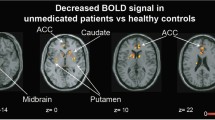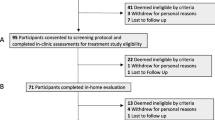Abstract
Rationale
The absence of a relationship between cognitive deficit treatment response and positive symptom treatment response is often assumed, and few data have shed light on this issue. Most of these data have been collected using standard neuropsychological measures, which are ill-designed to assess the types of neurocognitive disturbances associated with psychotic symptoms. This study investigates the effect of treatment on source monitoring performance and its relation to the reduction of certain psychotic symptoms associated with the inability to identify self-generated mental events, known as "autonoetic agnosia".
Objectives
To determine whether risperidone, olanzapine, and haloperidol were differentially effective in reducing autonoetic agnosia and whether changes in this aspect of cognition were related to reduction of specific symptoms of psychosis.
Methods
From a cohort of 49 patients diagnosed with schizophrenia by DSM-IV criteria and randomly assigned to double-blind treatment with risperidone, olanzapine, or haloperidol, 16 patients were identified with symptoms believed to reflect autonoetic agnosia ("target symptoms") as assessed with the Schneiderian Symptom Rating Scale, and then evaluated during a baseline period, and then at 1, 2, and 3 weeks. Autonoetic agnosia was assessed as the ability of a patient to distinguish self-generated words from both experimenter-generated words and pictorially presented words.
Results
Analysis of patients from all treatment groups found a significant reduction in the number of "target" Schneiderian symptoms. Discrimination for items from the self-generated and heard sources significantly improved with treatment, as did the number of self-generated items that patients remembered as coming from the heard source ("self-hear errors"). The correlation between improvement in recognition of self-generated items and reduction in target Schneiderian symptoms after 2 weeks of treatment suggested a modest relationship between symptom improvement and changes in autonoetic agnosia.
Conclusions
While the differences between medications were not statistically significant, antipsychotic medication in general was associated with improvements in symptoms and cognitive deficits that may underlie autonoetic agnosia. Improvement of autonoetic agnosia was a weak predictor of positive symptom improvement in a limited sample.





Similar content being viewed by others
References
Addington J, Addington D, Maticka-Tyndale E (1991) Cognitive functioning and positive and negative symptoms in schizophrenia. Schizophr Res 4:123–134
Amador XF, Strauss DH, Yale SA, Gorman JM (1991) Awareness of illness in schizophrenia. Schizophr Bull 17:113–132
Battig WF, Montague WE (1969) Category norms for verbal items in 56 categories: a replication and extension of the Connecticut category norms. J Exp Psychol Monogr 80:1–46
Bentall RP, Baker GA, Havers S (1991) Reality monitoring and psychotic hallucinations. Br J Clin Psychol 30:213–222
Braff DL, Heaton R, Kuck J Cullum M, Moranville J, Grant I, Ziscook S (1991) The generalized pattern of neuropsychological deficits in outpatients with chronic schizophrenia with heterogeneous Wisconsin Card Sorting Test results. Arch Gen Psychiatry 48:891–898
Cuesta MJ, Peralta V (1995) Cognitive disorders in the positive, negative and disorganization syndromes of schizophrenia. Psychiatry Res 58:227–235
Davidson M, Keefe RSE (1995) Cognitive impairment as a target for pharmacological treatment in schizophrenia. Schizophr Res 17:123–129
Dixon MJ, King S (1995) The concordance between symptom information gathered from remitted schizophrenic patients and their relatives. J Psychiatr Res 29:447–456
Frith CD (1992) The cognitive neuropsychology of schizophrenia. Erlbaum, Hove, UK
Frith CD, Done DJ (1989) Experiences of alien control in schizophrenia reflect a disorder in the central monitoring of action. Psychol Med 19:359–363
Gold JM, Harvey PD (1993) Cognitive deficits in schizophrenia. Psychiatr Clin N Am 16:295–312
Goldberg TE, Gold JM, Greenberg R, Griffin S, Schulz SC, Pickar D, Kleinman JE, Weinberger DR (1993) Contrasts between patients with affective disorders and patients with schizophrenia on a neuropsychological test battery. Am J Psychiatry 150:1355–1362
Green MF (1996) What are the functional consequences of neurocognitive deficits in schizophrenia? Am J Psychiatry 153:321–330
Green MF, Marder SR, Glynn SM, McGurk SR, Wirshing WC, Wirshing DA, Liberman RP, Mintz J (2002) The neurocognitive effects of low-dose haloperidol: A two-year comparison with risperidone. Biol Psychiatry 51:972–978
Harvey PD, Keefe RSE (1997) Cognitive impairment in schizophrenia and implications of atypical neuroleptic treatment. CNS Spectrums 2:1–11
Harvey PD, Keefe RSE (2001) Studies of cognitive change in patients with schizophrenia following novel antipsychotic treatment. Am J Psychiatry 158:176–184
Hashtroudi S, Johnson MK, Chrosniak LD (1989) Aging and source monitoring. Psychol Aging 4:106–112
Hirshman E, Bjork RA (1988) The generation effect: support for a two-factor theory. J Exp Psychol [Learn Mem Cognit] 14:484–494
Johnson MK, Raye CL (1981) Reality monitoring. Psychol Rev 88:67–85
Johnson MK, Hashtroudi S, Lindsay DS (1993) Source monitoring. Psychol Bull 114:3–28
Keefe RSE (1998) The neurobiology of disturbances of the self: Autonoetic agnosia in schizophrenia. In: Amador XF, David A (eds) Insight and psychosis. Oxford University Press, New York, pp 142–173
Keefe RSE, Mohs RC, Losonczy MF, Davidson M, Silverman JM, Kendler KS, Nora R, Horvath TB, Davis KL (1987) Characteristics of very poor outcome schizophrenia. Am J Psychiatry 144:889–895
Keefe RSE, Arnold MC, Bayen UJ, Harvey P (1999a) Source monitoring deficits in patients with schizophrenia: a multinomial modeling analysis. Psychol Med 29:903–914
Keefe RSE, Silva SG, Perkins DO, Lieberman JA (1999b) The effects of atypical antipsychotic drugs on neurocognitive impairment in schizophrenia: a review and meta-analysis. Schizophr Bull 25:201–222
Keefe RSE et al. (2000) Treatment of neurocognitive deficits with olanzapine or haloperidol in first episode psychosis. Presented at the Annual Meeting of the American College of Neuropsychopharmacology, San Juan, December
Keefe RSE, Arnold MC, Bayen UJ, McEvoy JP, Wilson WH (2002) Source monitoring deficits for self-generated stimuli in schizophrenia: multinomial modeling of data from three sources. Schizophr Res 57:51–67
Manschreck TC, Maher BA, Waller NG, Ames D, Latham CA (1985) Deficient motor synchrony in schizophrenic disorders: clinical correlates. Biol Psychiatry 20:990–1002
Mlakar J, Jensterle J, Frith CD (1994) Central monitoring deficiency and schizophrenia symptoms. Psychol Med 24:557–564
Morris RG, Rushe T, Woodruffe PW, Murray RM (1995) Problem solving in schizophrenia: a specific deficit in planning ability. Schizophr Res 14:235–246
Perlick D, Mattis S, Stastny P, Silverstein B (1992) Negative symptoms are related to both frontal and nonfrontal neuropsychological measures in chronic schizophrenia. Arch Gen Psychiatry 49:245–246
Riefer DM, Rouder JN (1991) A multinomial modeling analysis of the mnemonic benefits of bizarre imaging. Mem Cognit 20:601–611
Schneider K (1959) Klinische Psychopathologie, 5th edn. Grune and Stratton, New York
Slamecka NJ, Graf P (1978) The generation effect: delineation of a phenomenon. J Exp Psychol [Hum Learn Mem] 4:592–604
Stirling JD, Hellewell JSE, Quraish N (1998) Self-monitoring dysfunction and the schizophrenic symptoms of alien control. Psychol Med 28:675–683
Strauss ME (1993) Relations of symptoms to cognitive deficits in schizophrenia. Schizophr Bull 19:215–231
Acknowledgements
This research was supported by grants to Dr. Keefe from the National Alliance for Research in Schizophrenia and Depression (NARSAD) and the Janssen Research Foundation.
Author information
Authors and Affiliations
Corresponding author
Rights and permissions
About this article
Cite this article
Keefe, R.S.E., Poe, M.P., McEvoy, J.P. et al. Source monitoring improvement in patients with schizophrenia receiving antipsychotic medications. Psychopharmacology 169, 383–389 (2003). https://doi.org/10.1007/s00213-003-1476-0
Received:
Accepted:
Published:
Issue Date:
DOI: https://doi.org/10.1007/s00213-003-1476-0




